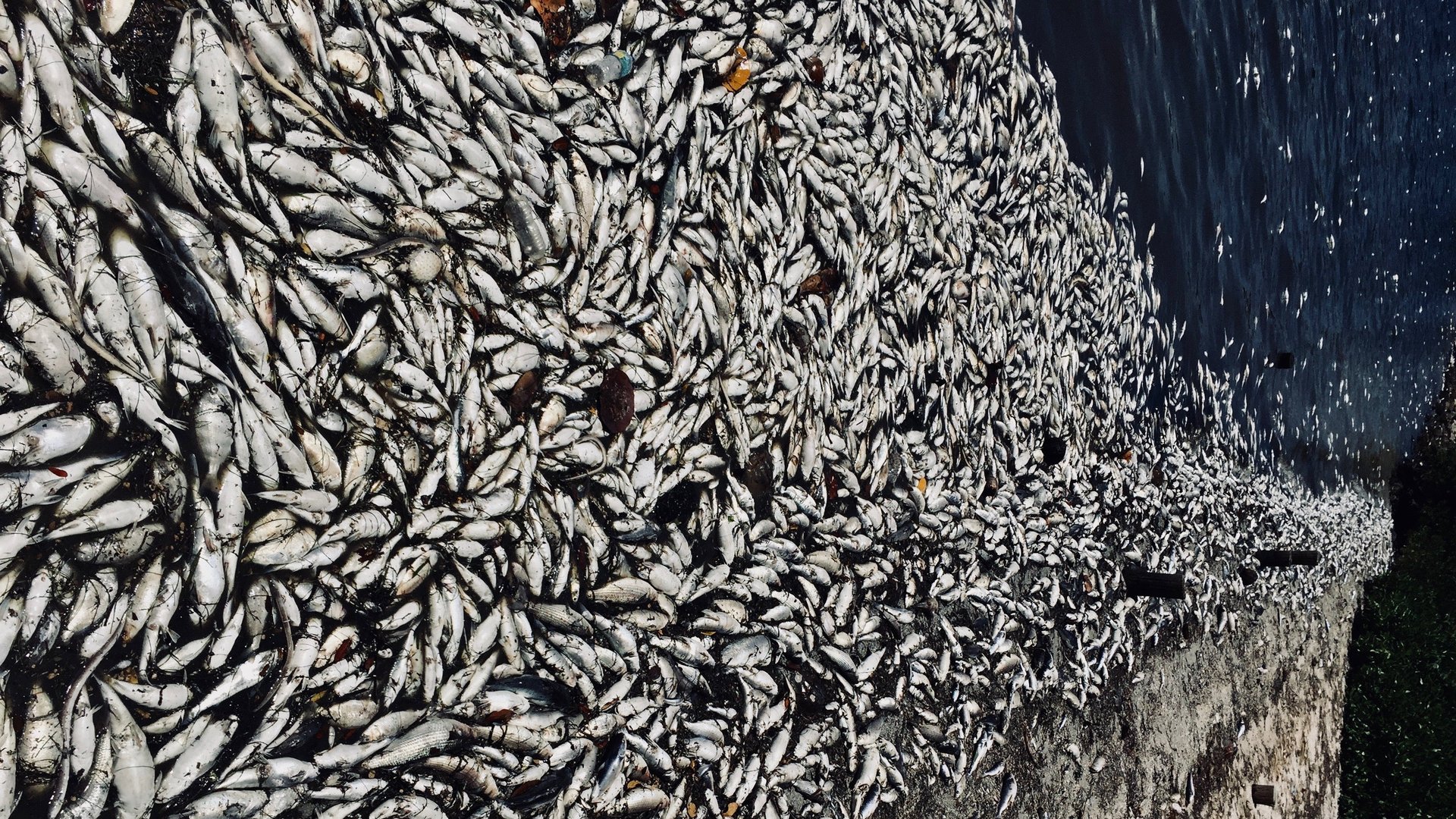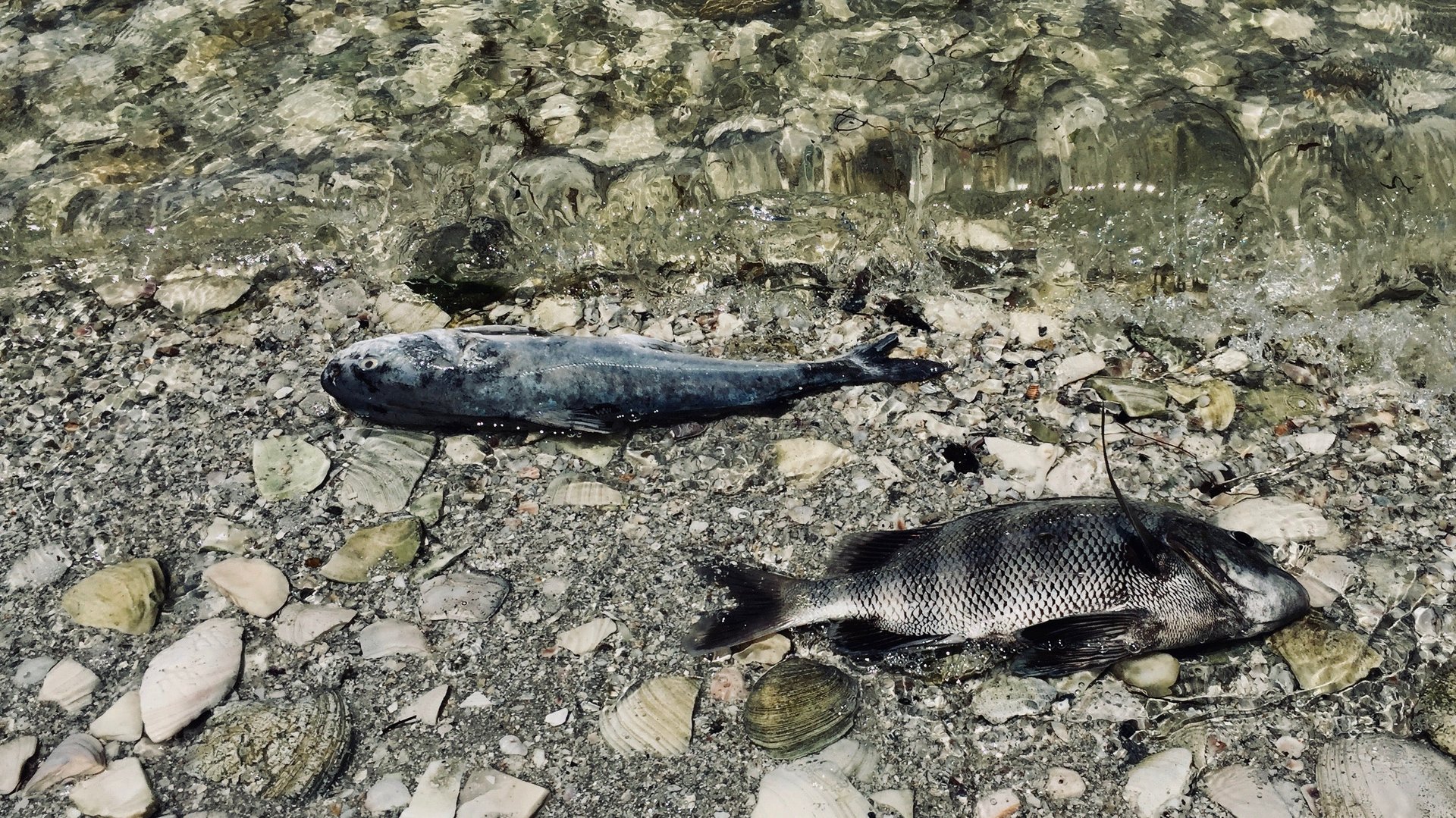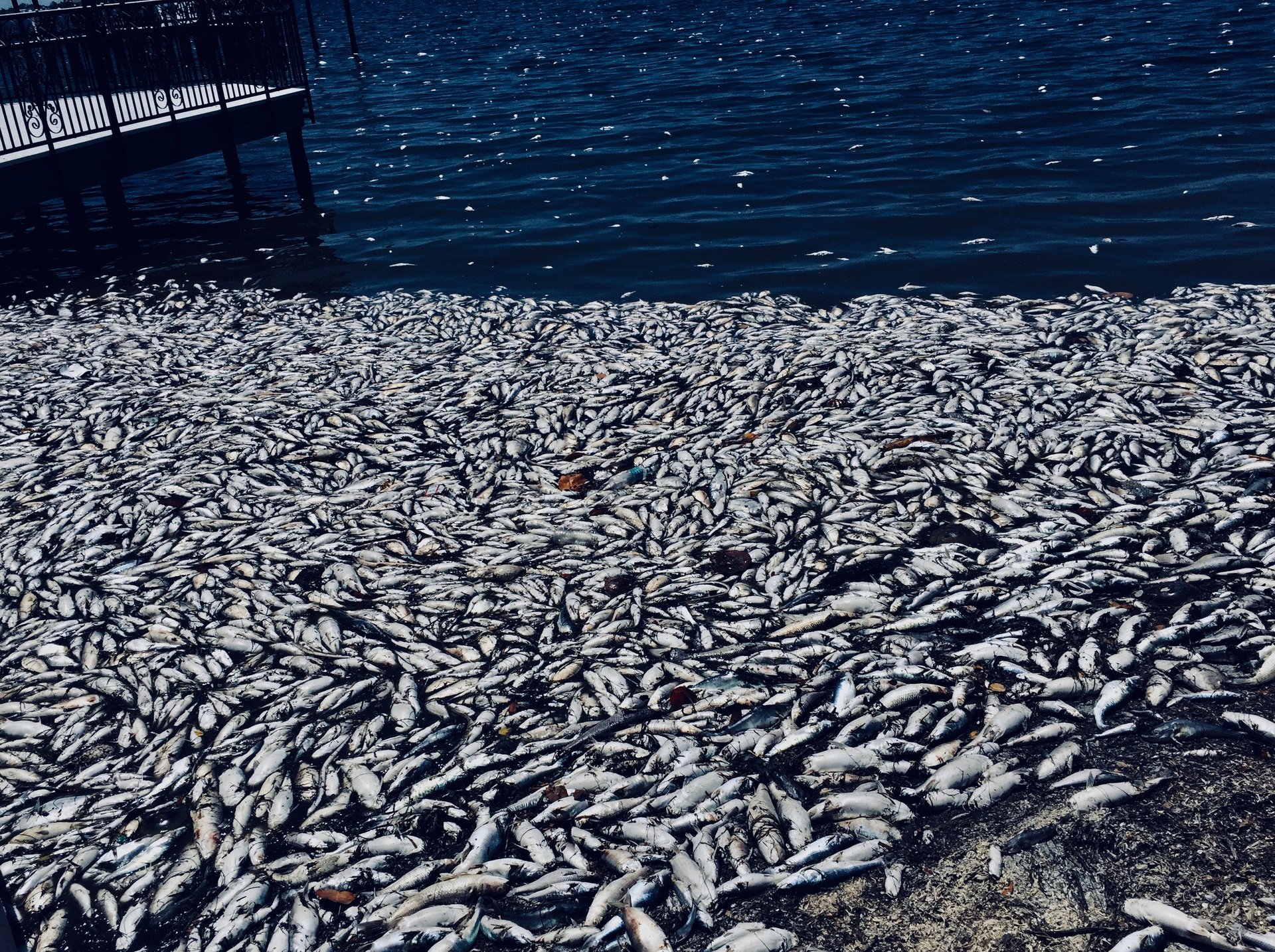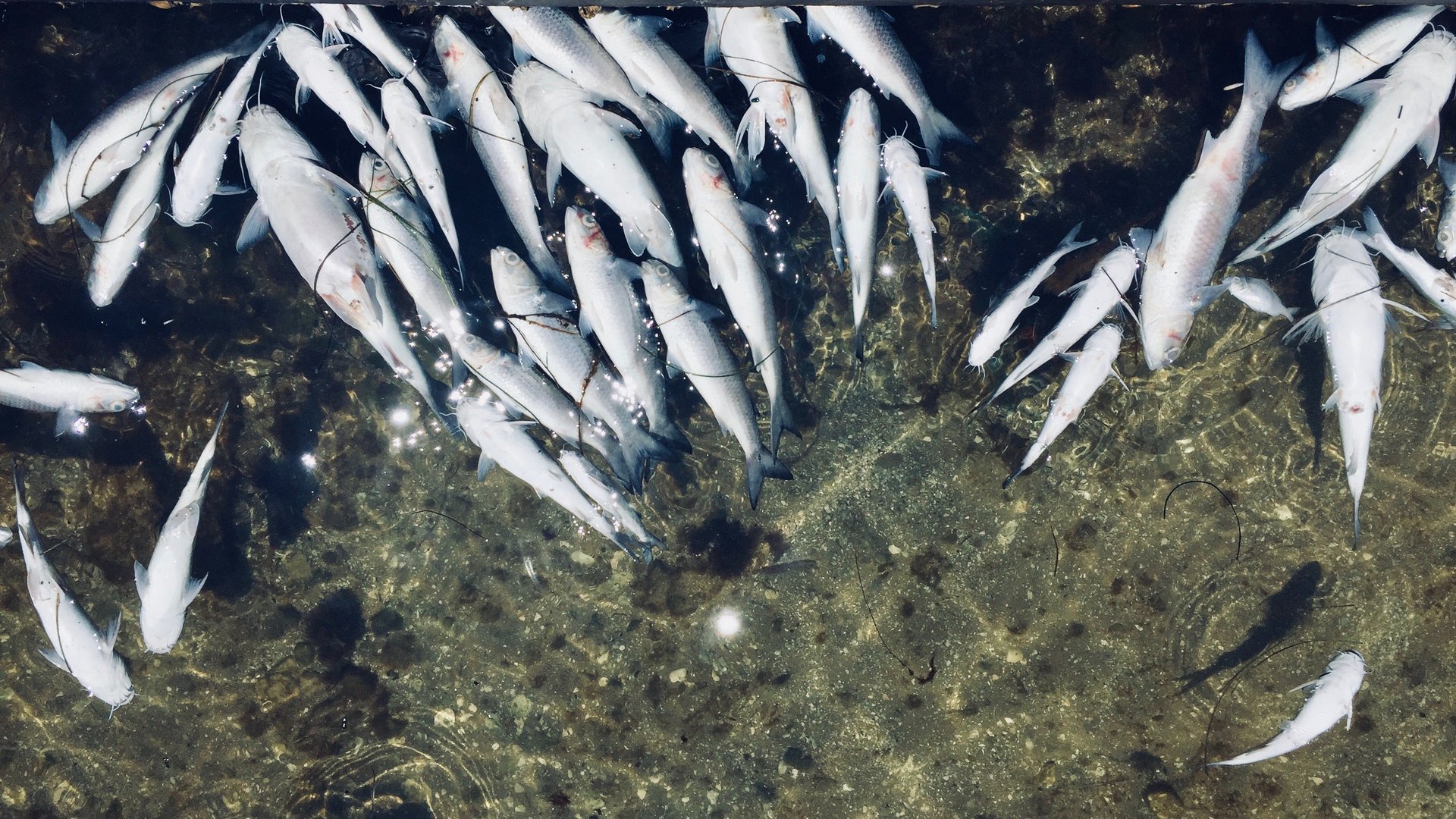Florida’s red tide crisis shows how climate change will make the world an ugly place
SARASOTA, FLORIDA, Aug. 22


SARASOTA, FLORIDA, Aug. 22
All the water birds—pelicans, egrets, cormorants—are gone.
Flies swarm the coast of the seaside city of Sarasota, Florida. Crows caw. The air stinks of death. Carpets of fish, belly-up, mouths gaping, line the shore. This is the putrid new world created by a toxic red algae bloom spanning 130 miles of the state’s west coast, which has so far killed masses of fish, 12 dolphins, more than 500 manatees, 300 sea turtles, countless horseshoe crabs, a whale shark, and the local economy.
The docks behind otherwise desirable condo buildings are surrounded by fish carcasses. The waters of the bay are dotted with them, silver and white, glinting in the hot sun, looking from a distance like the crests of thousands of small waves. At least 100 tons of sea creatures have fallen victim to the toxic bloom known as “red tide.” Meanwhile, when breezes blow the toxin inland, people cough, and reports of respiratory problems are on the rise in local hospitals.
The bloom occurs almost annually in Florida. But its effects this year have been exceptionally devastating. It’s a terrifying sight to behold, and a stark foreshadowing of what may become commonplace as climate change transforms nature and our lives. Although scientists don’t know exactly what caused this particularly vicious red algae bloom, they do believe that warming waters brought on by human-induced weather changes and the effects of building development have contributed to the ever-more extreme red tides of the last half-century.
There’s a lot of talk about the threats posed by climate change—to animals, people, and the environment. But abstract chatter is hard to fathom. We can’t really imagine what it will be like when the reality we know is replaced, and what’s beautiful turns to rot. The red tide in Florida doesn’t just make the issue of global warming visible; it’s an all-out sensory onslaught. And it’s a reminder that climate change isn’t just dangerous. It’s also going to make the world an increasingly ugly and unpleasant place.
A state of emergency

On Aug. 13, Florida governor Rick Scott declared a state of emergency in Hillsborough, Collier, Lee, Charlotte, Sarasota, Manatee and Pinellas counties. The order provides added funding and resources for clean-up efforts.
But money is no match for the sea. In Sarasota, the fish carcasses pile up again soon after they’re removed. Yachts are stalled in their dockside slips. Tourists are canceling trips. The sidewalk cafes and restaurants are empty. The tourism group Visit Sarasota County surveyed local businesses and found that 90% of 77 respondents—from hotels to jet-ski rental companies to restaurants— said they had lower sales between Aug. 1-7 because of the toxic algae and resulting dead fish. Locals, too, are staying inside, hiding from the heat and stench and signs of death, hoping that the region’s most redeeming feature, the water, will become hospitable again soon.
From bad to worse
Red tide is caused by massive blooms of the toxic organism Karenia brevis. The bloom is composed of millions of minuscule, single-celled plant-like organisms that produce chemicals as a defense, including the compound brevetoxin.

The toxic red algae, or something like it, was first reported in the 1500s by Spanish explorers (paywall) who spotted dead fish in unusual quantities on crimson-hued waters. It’s been officially documented by scientists since the mid-19th century.

The naturally-occurring bloom’s spread seems to have been exacerbated by human activities. In the last 60 years, red tides have become more severe. Some scientists posit (paywall) that this is a result of warming waters in the Gulf of Mexico. Warm waters boost algae growth, and the Gulf’s surface temperature has warmed by about two degrees Fahrenheit since 1977, as oceans soak up more heat in the atmosphere from ever-increasing carbon dioxide emissions.
Also notable is the fact that human endeavors have reshaped the flow of Florida’s waters. Agriculture, building development, canals, levees, and dikes have all changed the way rainwater, containing phosphorous and nitrogen from farm fertilizers, is directed. The rainwater runoff now rushes into rivers and bays, and the nitrogen-laden flow coaxes algae blooms.
Another contributing factor to this year’s red tide: About a year ago, in September of 2017, hurricane Irma struck Florida. The US Army Corps of Engineers had to release loads of nutrient-ridden water from Lake Okeechobee to limit water levels at the Hoover Dike. The latest red tide began about a month later.
Swimming against the red tide
In the face of the red tide’s devastation, scientists are working to address the issue with human ingenuity. For example, scientists at the Mote Marine Laboratory in Sarasota are attempting to find ways to fight red tide by pumping algae-ridden seawater through an ozone treatment system. Once clean, the purified water would be pumped back into the ocean.
This patented process, known as ozanation, is already used on a small scale to remove red tide in the water entering the Mote Aquarium and the organization’s marine mammal and sea turtle hospitals. Mote hasn’t yet said when this purification process might be perfected and put in place for larger-scale red tide reduction efforts. Whether this would lead to more unintended consequences is, of course, unknown.

Similarly, scientists at Mote are considering concentrating parasitic seaweed in Gulf of Mexico waters to fight the toxic red algae. The seaweed does kill red tide in the lab, but it’s not yet clear that concentrations of the stuff in the ocean will be effective or safe.
“Whatever we do, it has to be ecologically sound, it has to be economically feasible and logistically attainable,” Mote Laboratory researcher Richard Pierce, told residents of Venice, Florida, at an Aug. 19 special city council meeting to address red tide. That is perhaps a tall order, yet one that must be filled soon for the coasts to remain livable.
There seem to be no signs that the red tide is abating. It’s impossible to look at the fish carcasses piling up and the empty city and not wonder if the dismal future predicted by environmental scientists is already here. If so, it’s not a pretty sight to behold.